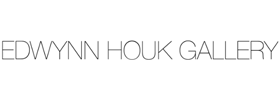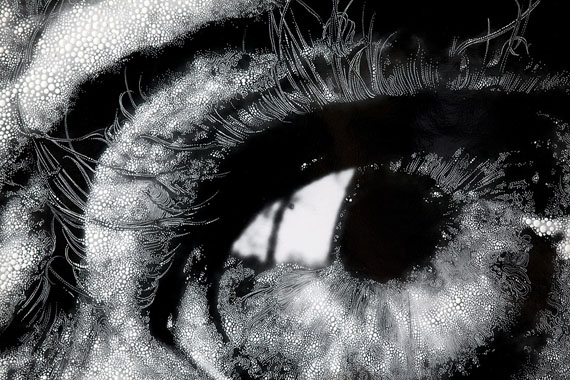
Unique hand-painted gelatin silver enlargement print with mixed media, 43 7/8 x 40 1/16 inches
Sebastiaan Bremer »
Eyes
Exhibition: 9 Jun – 28 Jul 2012
Sat 9 Jun 18:00
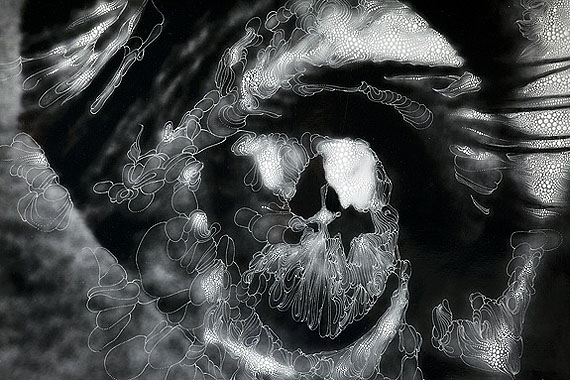
Unique hand-painted gelatin silver enlargement print with mixed media, 48 x 38 9/16 inches
Sebastiaan Bremer
Eyes
Galerie Edwynn Houk is pleased to announce the opening of an exhibition of new works by Sebastiaan Bremer (Dutch, b. 1970). The show begins on Saturday, 9 June and runs through Saturday, 28 July 2012. The artist will be present at the opening reception on Saturday, 9 June 2012, from 6-8pm.
"Bremer’s technique is novel and utterly hybrid. Using various inks, he draws directly on slightly blurry c-print enlargements of photographs, and often adds splotches and streaks of photographic dye. Almost always, the underlying photographic images have much to do with personal and family history; a best friend from Bremer’s teenage years, a shot of himself as a kid, a view of a room taken from under his grandmother’s piano, his family on vacation, a former girlfriend. These are the unpretentious snapshot images, the family album images, the photographic mementoes of a life that Bremer meticulously and obsessively draws on. So meticulously, in fact, and with such fine, tiny lines that you figure he either uses a magnifying glass or is in a trance (neither is the case). In some of Bremer’s works the underlying image is quite clear, while in others it’s almost totally obscured, but in any event one sees it through a scrim or a veil of intense surface activity, which can be at once elaborately ornamental, psychedelic, playful (replete with suggestions of doodling), turbulent, and downright magical. Always, Bremer’s found photographs become dreamlike and fantastical, and two opposite impulses are fused; documentation and hallucination. Moreover, while Bremer admits to a high level of automatism in devising his drawings, you also sense that this automatism involves a great deal of complex human feeling, ranging from harrowing fears and losses to whimsy and blissful response." (Excerpted from “The more you look, the more you see” by Gregory Volk, 2004)
Utilizing the artist’s signature style of obsessively applied dots of paint onto a glossy photographic surface, Bremer renders his subjects in breathtaking detail. Ranging in theme from nudes to landscapes, still life to family, the uniting element here is the artist’s capability to combine imagery from art of the Dutch Golden Age (which surrounded him during his youth in Amsterdam) with the seductive and dream-like abstractions that he lays over his appropriated photographs.
In the work illustrated here, “Eye #1, 2012”, Bremer began with a black & white photograph by Bill Brandt (British, b. Germany, 1904-1983) titled “Max Ernst’s Left Eye, 1963” from Brandt’s series of artist’s eyes. Separating the eye from the context of the face was a common motif of the Surrealists whose works were often based on experimentation, automatism, and eroticism - lending themselves to chance and resulting in changing the way we define looking at art. Bill Brandt was focusing on the eye of the artist and on the unique manner in which each artist observes the world and, in turn, filters and reinterprets it for their viewers.
Conversely, Bremer creates his unique work by altering and reinterpreting the existing image, a device more commonly used by contemporary artists and one that lends itself to highlighting the artist’s individual technique over its subject matter.
Still, to experience seeing these large staring “Eyes,” is an invitation to interpret Bremer’s subject matter. We are seduced to look into the very heart of the oculus, the place we are normally forbidden to stare into and to closely examine the geography of the eye. We are presented with the origins of sight, precisely how and what the eye sees and rewarded with images reflected in the pupil here. At the same time, we begin to explore optics, perception, the gaze, and in effect, the vocabulary of this series. Abstract and whimsical, the painted highlights of the lines and hairs around the eyes come together as works that vacillate between landscape and portraiture, psychedelic topography, op-art fantasy, and that inexplicable space between the physical body and the imagination.
Sebastiaan Bremer lives and works in New York. He studied at the Vrije Academie, The Hague, and Skowhegan School of Art and Sculpture, Maine. He has published two major catalogs: Monkey Brain (2003), and Avila (2006). His work is included in the collections of the Museum of Modern Art, New York, the Los Angeles County Museum of Art, and the Victoria and Albert Museum, London, among several others. A major one-person exhibition and publication is planned for 2013 at the Huis Marseille/Museum for Photography in Amsterdam.
Sebastiaan Bremer
Eyes
9. JUNI - 28. JULI 2012
VERNISSAGE: SAMSTAG, DEN 9. JUNI 2012, 18 - 20 UHR
DER KÜNSTLER WIRD ANWESEND SEIN.
Die Galerie Edwynn Houk freut sich, eine Ausstellung mit neuen Arbeiten des niederländischen und in Brooklyn lebenden Künstlers Sebastiaan Bremer (Jg. 1970) am Samstag, den 9. Juni eröffnen zu können. Der Künstler wird zur Vernissage von 18 bis 20 Uhr anwesend sein. Die Ausstellung läuft bis zum 28. Juli 2012.
"Bremers Technik ist neuartig und völlig hybride. Mit verschiedenen Tinten zeichnet er direkt auf leicht unscharfe Farbvergrösserungen von Fotografien und fügt ihnen mit fotografischen Tonern oft noch Kleckse und Schlieren bei. Die zugrunde liegenden Fotografien haben fast immer etwas mit persönlicher und Familiengeschichte zu tun; der beste Freund aus Bremers Jugendjahren, Aufnahmen von ihm selbst als Kind, eine Zimmeransicht aufgenommen von unter dem Piano seiner Grossmutter, sein Familienurlaub, eine ehemalige Freundin. Es sind unprätentiöse Schnappschüsse, Bilder aus dem Familienalbum, die fotografischen Andenken eines Lebens von denen Bremer akribisch und obsessiv zehrt. Und zwar so akribisch und mit solch feinen und winzigen Linien, dass man annimmt, er benutzt eine Lupe oder ist in Trance (beides ist nicht der Fall). In einigen seiner Arbeiten ist das zugrundeliegende Bild recht deutlich, während es in anderen fast völlig unkenntlich ist. In jedem Fall kann man aber durch die Webstruktur oder den Schleier aus intensiven Oberflächenaktivitäten hindurchsehen, welche gleichzeitig aufwendig ornamental, psychedelisch, verspielt (reichlich versehen mit Andeutungen von Kritzeleien), turbulent und geradezu magisch sein können. Bremers gefundene Fotografien werden immer traumhaft und wundersam, und zwei entgegengesetzte Impulse verschmelzen; Dokumentation und Halluzination. Und während Bremer einen hohen Grad von Automatismus in der Gestaltung seiner Zeichnungen eingesteht, so merkt man aber auch, dass dieser Automatismus sehr mit komplexen menschlichen Gefühlen verbunden ist, welche von erschütternden Ängsten und Verlusten bis hin zu Launen und glückseligen Resonanzen reichen."(Auszug aus „The more you look, the more you see” von Gregory Volk, 2004)
In dem für ihn typischen Stil zeichnet Bremer seine Darstellungen obsessiv und in erstaunlichem Detail via aufgetragener Farbpunkte auf die glänzende Oberfläche fotografischer Abzüge. Ob Akte oder Landschaften, Stilleben oder Familie, das vereinigende Element ist dabei immer seine Fähigkeit, Bilder aus dem golden Zeitalter der Niederlande (welche ihn während seiner Jugend in Amsterdam umgeben haben) mit verführerischen und imaginären Abstraktionen zu kombinieren, um damit die von ihm angeeigneten Fotografien zu überziehen.
Bremers Ausgangspunkt in dem hier illustrierten Werk, „Eye #1, 2012“, war eine Schwarzweissfotografie des in Deutschland geborenen Briten Bill Brandt (1904-1983) mit dem Titel „Max Ernst’s Left Eye, 1963“, aus Brandts Serie von Künstleraugen. Das Auge aus dem Kontext des Gesichts herauszunehmen war ein recht gebräuchliches Motiv der Surrealisten, deren Arbeiten oft auf Experimentieren, Automatismus und Erotik beruhten – was ihnen dem Zufall zuträglich machte und so unsere Art, Kunst zu betrachten, grundsätzlich veränderte. Bill Brandt hatte seinen Akzent vor allem auf Künstleraugen gesetzt und dabei gerade auch auf die einzigartige Weise, wie jeder Künstler die Welt betrachtet und diese für das Kunstpublikum filtert und neu deutet.
Umgekehrt schafft Bremer Unikate, in dem er ein schon existierendes Bild verändert und neu interpretiert, eine Methode, die eher in der zeitgenössischen Kunst verankert ist und die sich besonders dazu eignet, die dem Künstler eigene Technik zu betonen, statt allein den Inhalt der Arbeit.
Und doch ist das Erlebnis in diese grossen “Augen” zu schauen, auch eine Einladung, Bremers Thematik zu deuten. Wir werden hier verführt, tief ins normalerweise als unerlaubt geltende Zentrum des Sehorgans zu blicken, um so die Geographie des Auges zu erkunden. Uns wird der Ursprung des Sehens präsentiert, genau wie und was das Auge sieht, und wir werden dabei mit Bildern belohnt, die sich hier in den Pupillen spiegeln. Gleichzeitig erkunden wir aber auch die Optik, die Wahrnehmung, den Blick und, in der Tat, das Vokabular dieser Serie. Abstract und skurril, werden die vom Künstler in Tinte hervorgehobenen Falten und Haare um die Augen zu Arbeiten, die zwischen Landschaft und Porträt, psychedelischer Topographie, Op-Art Fantasie und dem unerklärlichen Ort zwischen Körper und Vorstellungsgabe hin und her schwanken.
Sebastiaan Bremer lebt und arbeitet in New York. Er studierte an der Vrije Academie, Den Haag, und der Skowhegan School of Art and Sculpture, Maine. Er hat mit Monkey Brain (2003) und Avila (2006) zwei wichtige Kataloge veröffentlicht. Seine Arbeiten befinden sich unter anderem in den Sammlungen des Museum of Modern Art in New York, dem Los Angeles County Museum und dem Victoria and Albert Museum in London. Eine grosse Einzelausstellung mit Publikation wird 2013 im Huis Marseille/Museum für Fotografie in Amsterdam stattfinden.
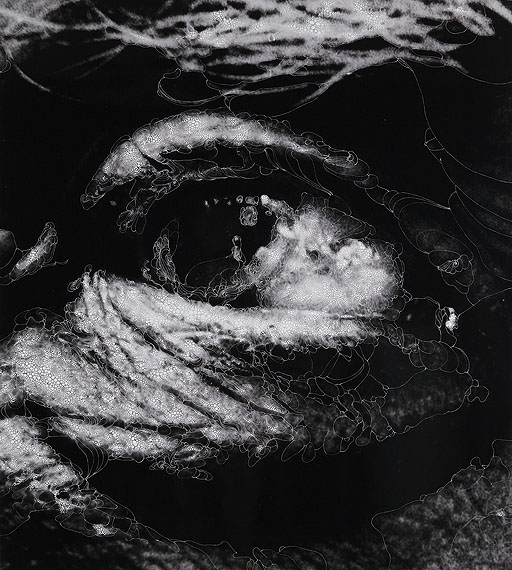
Unique hand-painted gelatin silver enlargement print with mixed media, 44 3/4 x 40 1/16 inches
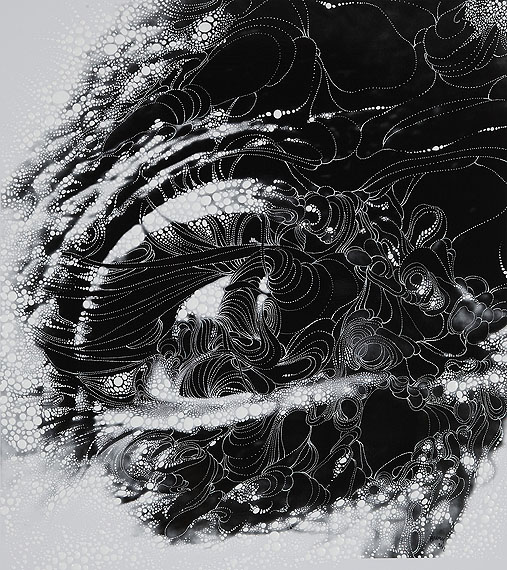
Unique hand-painted gelatin silver enlargement print with mixed media, 15 7/16 x 14 inches
